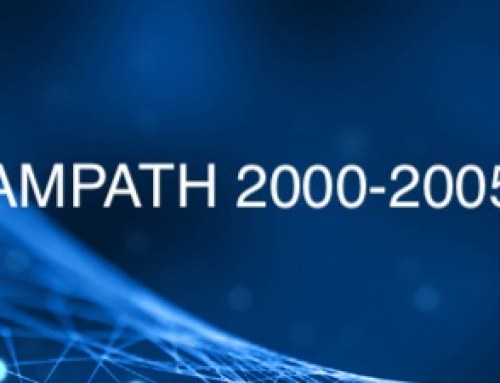AMPATH Astronomy Working Group
Chair: Eduardo Vera, esvera@accessnova.cl
Mailing list: astronomy-wg@ampath.net
Most recent meeting: January 31, 2003, at the AMPATH Conference in Miami, FL.
Astronomy projects in the AMPATH service area:
GEMINI: The Gemini Project has just connected its two telescopes in Mauna Kea (Hawaii) and Cerro Pachon (Chile) via Internet2. The Gemini Project is an international partnership with two 8.1-meter telescopes (each telescope has a main mirror over 26 feet across.) One telescope is located on Hawaii’s Mauna Kea, and the other on Chile’s Cerro Pachón. The name Gemini comes from the mythological twins, whose stars will be visible to both telescopes. See http://www.gemini.edu for more information.
ESO: Other important optical telescopes facilities are Cerro Tololo (Interamerican Observatory) and Las Campanas. Also, the two ESO (European Southern Observatory) facilities La Silla and Paranal. These are all candidates for future high-speed network access. The European Southern Observatory is an intergovernmental, European organization for astronomical research. It has ten member countries. ESO operates astronomical observatories in Chile and has its headquarters in Garching, near Munich, Germany. See http://www.eso.org/ for more information.
ALMA: The ALMA radio observatory is a combined effort of the USA (NRAO) and Europe (ESO), with the likely addition of Japan (NAOJ). Construction is scheduled to start in the 2004-2006 timeframe with full completion towards the end of the decade, in the 2010-2011 timeframe. See http://www.alma.nrao.edu/ for more information.
Environmental monitoring in South America could be another area of great potential interest to US science. For instance, being an earthquake country, Chile is a good candidate for geophysics research as well. At AccessNova-UChile, we are presently involved in research work to connect earthquake sensors to IP data networks, with web-based access. See http://www.accessnova.cl/ for more information on the AccessNova project.
The Arecibo Observatory is part of the National Astronomy and Ionosphere Center (NAIC), a national research center operated by Cornell University under a cooperative agreement with the National Science Foundation (NSF). Additional support is provided by the National Aeronautics and Space Administration (NASA). The Observatory operates on a continuous basis, 24 hours a day every day, providing observing time, electronics, computer, travel, and logistic support to scientists from all over the world. All results of research are published in the scientific literature which is publicly available. As the site of the world’s largest single-dish radio telescope, the Observatory is recognized as one of the most important national centers for research in radio astronomy, planetary radar, and terrestrial aeronomy. Use of the Arecibo Observatory is available on an equal, competitive basis to all scientists from throughout the world. See http://www.naic.edu/open.htm for more information.
Atmospheric & Oceanographic Working Group
Chair: Azael Barrera, SENACYT abarrera@senacyt.gob.pa
Mailing list:
Next Meeting: January 31, 2003, at the AMPATH Conference in Miami, FL.
Tentative agenda
There are various aspects of interests on Atmospheric and Oceanographic issues that were discussed in the Internet2 meeting, that this working group was proposed to help coordinate new types of collaboration on these issues within AMPATH.
The meeting for the newly proposed Atmospheric & Oceanographic Working Group will focus on the following aspects:
– Identification of the community working in A&O problems using or in need of the network facilities and services
– Find common ground for collaboration between networking support groups and the multidisciplinary community working in A&O and related issues in the AMPATH region
– Discuss possible collaborative projects from national initiatives and strategies to propose these projects (eg. Pacific ocean remote instrumentation, El Niño remote monitoring, etc.)
The agenda is open for suggestions. Members interested in participating and supporting this group are encouraged to submit a topic to the chair. Updates in infrastructure that will support this area are encouraged, too. Please send your contributions and suggestions before January 25th to have a some topics for discussions to start with.
We hope to have you to come as early as possible after the lunch break to attend the first session of the AMPATH A&O WG.
Digital Data Collaboration Working Group
Chair: Liane Tarouco
Mailing list:
Next Meeting: January 31, 2003, at the AMPATH Conference in Miami, FL.
Discussion Topics:
- Data Collaboration technology– trends and standardization efforts – Liane Tarouco
- Digital Vídeo – Guido Lemos [Digital Video Presentation]
- VRVS – David Collados Polidura
- Group participants self-presenting and discussion of possible scope for the working group
- Discussion of WG Mission and Goals; future projects
– Discuss possible collaborative projects from national initiatives and strategies to propose these projects (eg. Pacific ocean remote instrumentation, El Niño remote monitoring, etc.)
The agenda is open for suggestions. Members interested in participating and supporting this group are encouraged to submit a topic to the chair. Updates in infrastructure that will support this area are encouraged, too. Please send your contributions and suggestions before January 25th to have some topics for discussions to start with.
We hope to have you to come as early as possible after the lunch break to attend the first session of the AMPATH A&O WG.
High Energy Physics Working Group
In conjunction with the Internet2 HENP Working Group, Harvey Newman & Shawn McKee, Co-Chairs
Proposed Chair: Alberto Santoro, santoro@fnal.gov
Mailing list: henp-wg@ampath.net
Next working group meeting:
February 1, 2003, in Miami, Florida in conjunction with AMPATH (http://www.ampath.fiu.edu/Miami2003.htm) and the Joint Techs meeting (http://www.ncne.org/training/techs/2003/0202/jt-miami.html).
This meeting will focus on finding common ground with the Astronomy community since we have very complimentary modes of utilizing the network.
The agenda is still open for suggestions. Please send along ideas for discussions or let us know if you would like to present on a topic. We will likely have an update from one or two of our goal contacts on their status.
Since the focus is on collaborating with Astronomy, we want to encourage as many of you as possible to arrive early to attend the Astronomy WG session on January 31st (see http://www.ampath.fiu.edu/wg/astronomy_wg_agenda.htm).
Shawn McKee
Harvey Newman
HENP Working Group

